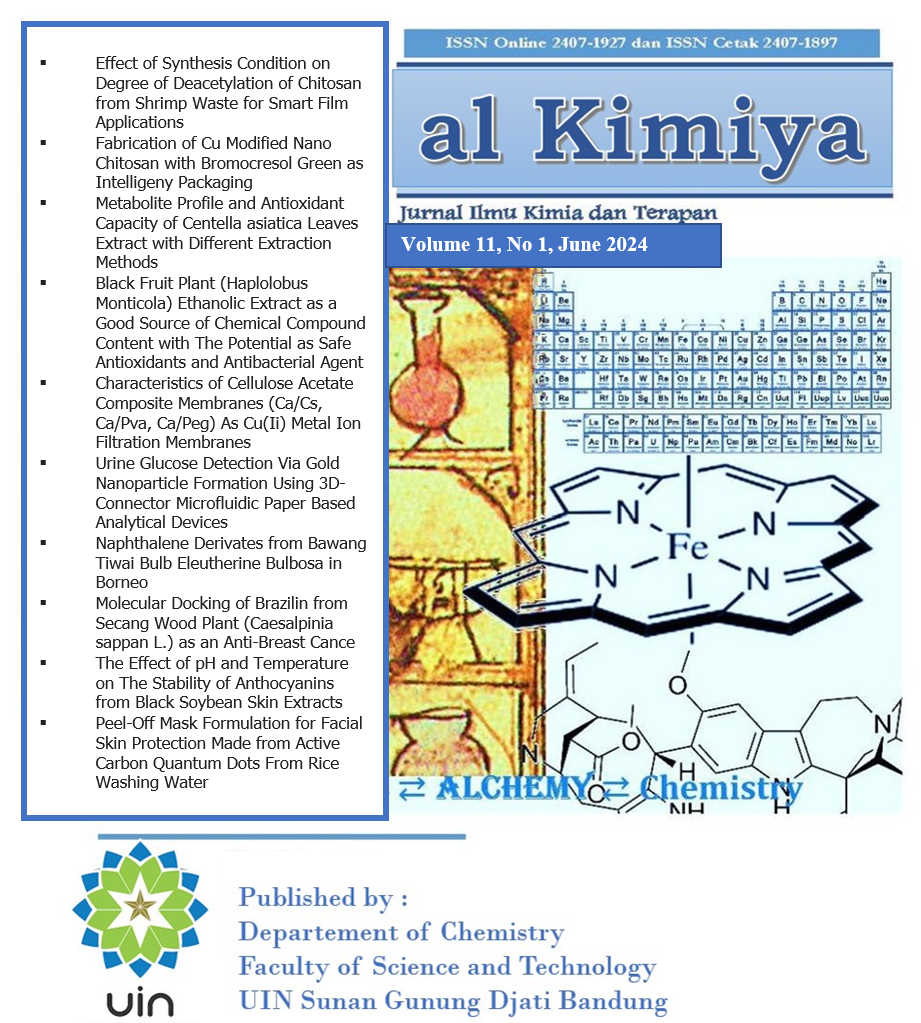Molecular Docking of Brazilin from Secang Wood Plant (Caesalpinia sappan L.) as an Anti-Breast Cancer
DOI:
https://doi.org/10.15575/ak.v11i1.35590Keywords:
brazilin, secang, molecular docking, receptor, breast cancerAbstract
References
S. Suyatmi, A. Mudigdo, B. Purwanto, D. Indarto, F. A. Hakim, and D. I. Krisnawati, “Brazilin isolated from Caesalpina sappan wood induces intrinsic apoptosis on A549 cancer cell line by increasing p53, caspase-9, and caspase-3,†Asian Pacific Journal of Cancer Prevention, 23 (4), 1337–1343, 2022, https://doi.org/10.31557/APJCP.2022.23.4.1337
Ministry of Health Republic of Indonesia, Indonesian Health Profile 2020. Jakarta, 2021.
I. P. W. Nugraha, I. W. Suwartawan, P. A. A. Prayoga, N. P. L. Laksmiani, I. G. P. Putra, and N. K. S. Ani, “Potensi brazilein dari kayu secang (Caesalpinia sappan L.) sebagai agen depigmentasi kulit secara In Silico,†Jurnal Farmasi Udayana, 7(1), 2018, https://doi.org/10.24843/JFU.2018.v07.i01.p02
R. Rachmady, L. Muntafiah, F. Rosyadi, I. Sholihah, S. Handayani, and R. I. Jenie, “Antiproliferative effect of secang heartwood ethanolic extract (Caesalpinia sappan L.) on HER2-Positive breast cancer cells,†Indonesian Journal of Cancer Chemoprevention, 7(1), 1–5, 2017, https://doi.org/10.14499/indonesianjcanchemoprev7iss1pp1-5
C. N. Raptania, S. Zakia, A. I. Fahira, and R. Amalia, “Article review: Brazilin as potential anticancer agent,†Frontiers in Pharmacology, 15 (1355533). Frontiers Media SA, pp. 1–9, 2024. https://doi.org/10.3389/fphar.2024.1355533
T. Vij et al., “A comprehensive review on bioactive compounds found in Caesalpinia sappan,†Molecules, 28 (17), 1–22, 2023, https://doi.org/10.3390/molecules28176247
R. Sari and Suhartati, “Secang (Caesalpinia sappan L.) : tumbuhan herbal kaya antioksidan,†Info Teknis EBONI, 13 (1), pp. 57–67, 2016. doi:10.20886/buleboni.5077
M. Mazumdar, D. Fournier, D. W. Zhu, C. Cadot, D. Poirier, and S. X. Lin, “Binary and ternary crystal structure analyses of a novel inhibitor with 17β-HSD type 1: A lead compound for breast cancer therapy,†Biochemical Journal, 424 (3), 357–366, Dec. 2009, https://doi.org/10.1042/BJ20091020
C. I. Gonçalves, J. Carriço, M. Bastos, and M. C. Lemos, “Disorder of sex development due to 17-Beta-Hydroxysteroid dehydrogenase type 3 deficiency: A Case Report and Review of 70 Different HSD17B3 Mutations Reported in 239 Patients,†Int J Mol Sci, 23 (17), 2022, https://doi.org/10.3390/ijms231710026
F. Li et al., “SiRNA-based breast cancer therapy by suppressing 17β-hydroxysteroid dehydrogenase type 1 in an optimized xenograft cell and molecular biology model in vivo,†Drug Des Devel Ther, 13,757–766, 2019, https://doi.org/10.2147/DDDT.S180836
A. P. D. Harnis, N. A. H. M. Hasan, Y. K. Janah, C. A. Tsamara, and F. Fatchiyah, “Virtual inhibition analysis of bioactive compound Brazilin (Caesalpinia sappan L.) toward progesterone receptor or lonaprisan in breast cancer proliferation,†Biotropika: Journal of Tropical Biology, 8 (2), 62–70, 2020, https://doi.org/10.21776/ub.biotropika.2020.008.02.01
B. D. G. Page et al., “Targeted NUDT5 inhibitors block hormone signaling in breast cancer cells,†Nat Commun, 9 (250), 1–14, 2018, https://doi.org/10.1038/s41467-017-02293-7
N. D. Amalina, M. Suzery, B. Cahyono, and D. N. Bima, “Mengungkap potensi metabolit sekunder tanaman herbal Indonesia untuk menghentikan metastasis kanker payudara: Pendekatan in-silico,†Indonesian Journal of Chemical Science , 9 (3), 154–159, 2020, [Online]. Available:http://journal.unnes.ac.id/sju/index.php/ijcs
S. Nur, M. Hanafi, H. Setiawan, N. Nursamsiar, and B. Elya, “Molecular docking simulation of reported phytochemical compounds from Curculigo latifolia extract on target proteins related to skin antiaging,†Tropical Journal of Natural Product Research, 7 (11), 5067–5080,2023,https://doi.org/10.26538/tjnpr/v7i11.9
M. V. C. Grahl et al., “Evaluation of drug repositioning by molecular docking of pharmaceutical resources available in the Brazilian healthcare system against SARS-CoV-2,†Inform Med Unlocked, 23, 1–8, 2021, https://doi.org/10.1016/j.imu.2021.100539
C. Arjin et al., “Brazilin from Caesalpinia sappan inhibits viral infection against PRRSV via CD163ΔSRCR5 MARC-145 cells: an in silico and in vitro studies,†Sci Rep, 12 ( 21595), 1–15, 2022, https://doi.org/10.1038/s41598-022-26206-x
“BIOVIA discovery studio modeling environment,†2017, Dassault Systèmes, San Diego, CA. Accessed: Jul. 23, 2023. [Online]. Available: https://discover.3ds.com/discovery-studio-visualizer-download.
D. Dermawan, R. Sumirtanurdin, and D. Dewantisari, “Simulasi dinamika molekular reseptor Estrogen Alfa dengan Andrografolid sebagai anti kanker payudara,†Indonesian Journal of Pharmaceutical Science and Technology, 6(2), 65–76, 2019, https://doi.org/10.24198/ijpst.v6i2.18168
G. M. Morris et al., “Software news and updates AutoDock4 and AutoDockTools4: automated docking with selective receptor flexibility,†J Comput Chem, 30 (16), 2785–2791,2009,https://doi.org/10.1002/jcc.21256
M. Hahn, “Receptor surface models: definition and construction,†J. Med. Chem, 38, 2080–2090, 1995, https://doi.org/10.1021/jm00012a007
I. K. Klara, R. M. Purwono, and P. Achmadi, “Analisis in silico senyawa Flavonoid kayu secang (Caesalpinia sappan L.) pada reseptor α-Amilase sebagai Antihiperglikemik,†Acta Vet Indones, 11(3), 210–219, 2023, https://doi.org/10.29244/avi.11.3.210-219
L. Veterini et al., “In Silico study of the potential of garlic allicin compound as anti-angiogenesis in breast cancer,†Tropical Journal of Natural Product Research, 5 (11), 1995–1999, 2021, https://doi.org/10.26538/tjnpr/v5i11.17
M. N. Abdillah, N. R. Ilmah, and A. Bintang Mahardhika, “Penambatan molekuler senyawa Polifenolat terhadap enzim reverse transcriptase sebagai senyawa antiretroviral (HIV-1),†JSTFI Indonesian Journal of Pharmaceutical Science and Technology, 6(1), pp. 1-13,2017, https://doi.org/10.58327/jstfi.v6i1.59
Downloads
Published
Issue
Section
Citation Check
License
Authors who publish with this journal agree to the following terms:
- Authors retain copyright and grant the journal right of first publication with the work simultaneously licensed under a Creative Commons Attribution 4.0 International License that allows others to share the work with an acknowledgment of the work's authorship and initial publication in this journal.
- Authors are able to enter into separate, additional contractual arrangements for the non-exclusive distribution of the journal's published version of the work (e.g., post it to an institutional repository or publish it in a book), with an acknowledgment of its initial publication in this journal.
- Authors are permitted and encouraged to post their work online (e.g., in institutional repositories or on their website) prior to and during the submission process, as it can lead to productive exchanges, as well as earlier and greater citation of published work (See The Effect of Open Access).

